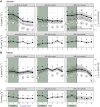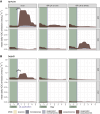Localized Response of De Novo Terpenoid Emissions Through the Jasmonate Signaling Cascade in Two Main European Tree Species
- PMID: 40740022
- PMCID: PMC12311559
- DOI: 10.1111/ppl.70432
Localized Response of De Novo Terpenoid Emissions Through the Jasmonate Signaling Cascade in Two Main European Tree Species
Abstract
The systemically induced production of volatile organic compounds (VOCs) in undamaged tissues of plants under herbivore attack is still not fully understood, particularly with respect to below- and aboveground signaling. Here, we test the hypotheses that treatment of trees with jasmonic acid (JA) to simulate local herbivory (i) systemically induces VOC emissions in leaves and roots by signal propagation via the vascular bundle system and (ii) that bidirectional signaling occurs between below- and aboveground organs. We applied JA to roots and branches of Fagus sylvatica and Picea abies in a controlled experiment and shielded untreated tissues from volatile cues. VOC emissions and gas exchange were measured continuously over 6-8 days and complemented by quantification of tissue terpenoid storage pools. In contrast to the strong increase in terpenoid emissions from directly treated leaves and needles, which were mainly composed of sesquiterpenes, no systemically induced terpenoid emissions were found. Direct JA treatment of shoots reduced net photosynthesis and stomatal conductance in P. abies by ~50%, while the gas exchange of F. sylvatica remained unaffected. In the root system of P. abies, terpenoid contents increased both locally and systemically in response to belowground JA treatment. Overall, our results challenge the concept of systemically induced terpenoid emissions through vascular JA signaling, which is commonly induced in trees in response to insect herbivory. Instead, our data point toward a possible role of volatile cues in intra-plant signaling.
Keywords: herbivore induced plant volatiles (HIPVs); roots; terpenoid storage pools; volatile organic compounds; within‐plant signaling.
© 2025 The Author(s). Physiologia Plantarum published by John Wiley & Sons Ltd on behalf of Scandinavian Plant Physiology Society.
Figures





Similar articles
-
Drought impairs herbivore-induced volatile terpene emissions by ponderosa pine but not through constraints on newly assimilated carbon.Tree Physiol. 2023 Jun 7;43(6):938-951. doi: 10.1093/treephys/tpad016. Tree Physiol. 2023. PMID: 36762917
-
Eco-evolutionary factors contribute to chemodiversity in aboveground and belowground cucurbit herbivore-induced plant volatiles.Plant Biol (Stuttg). 2025 Aug;27(5):847-860. doi: 10.1111/plb.13709. Epub 2024 Aug 20. Plant Biol (Stuttg). 2025. PMID: 39162182 Free PMC article.
-
Aphid Colony Size in Tansy is Affected by Plant Chemical Composition but not by Belowground Herbivory.J Chem Ecol. 2025 May 29;51(3):63. doi: 10.1007/s10886-025-01609-y. J Chem Ecol. 2025. PMID: 40442448 Free PMC article.
-
New insights into the role of the root system of epiphytic bromeliads: comparison of root and leaf trichome functions in acquisition of water and nutrients.Ann Bot. 2024 Nov 13;134(5):711-724. doi: 10.1093/aob/mcae109. Ann Bot. 2024. PMID: 39021206 Free PMC article. Review.
-
Drugs for preventing postoperative nausea and vomiting in adults after general anaesthesia: a network meta-analysis.Cochrane Database Syst Rev. 2020 Oct 19;10(10):CD012859. doi: 10.1002/14651858.CD012859.pub2. Cochrane Database Syst Rev. 2020. PMID: 33075160 Free PMC article.
References
-
- Arimura, G. , Huber D. P. W., and Bohlmann J.. 2004. “Forest Tent Caterpillars (<styled-content style="fixed-case"> Malacosoma disstria </styled-content>) Induce Local and Systemic Diurnal Emissions of Terpenoid Volatiles in Hybrid Poplar ( <styled-content style="fixed-case">Populus trichocarpa</styled-content> × deltoides): cDNA Cloning, Functional Characterization, and Patterns of Gene Expression of (−)‐germacrene D Synthase, PtdTPS1.” Plant Journal 37: 603–616. - PubMed
-
- Ballhorn, D. J. , Kautz S., Lion U., and Heil M.. 2008. “Trade‐Offs Between Direct and Indirect Defences of Lima Bean (<styled-content style="fixed-case"> Phaseolus lunatus </styled-content>).” Journal of Ecology 96: 971–980.
-
- Bertić, M. , Orgel F., Gschwendtner S., et al. 2023. “European Oak Metabolites Shape Digestion and Fitness of the Herbivore Tortrix viridana .” Functional Ecology 37: 1476–1491.
-
- Bezemer, T. M. , and van Dam N. M.. 2005. “Linking Aboveground and Belowground Interactions via Induced Plant Defenses.” Trends in Ecology & Evolution 20: 617–624. - PubMed
-
- Bezemer, T. M. , Wagenaar R., van Dam N. M., van Der Putten W. H., and Wäckers F. L.. 2004. “Above‐ and Below‐Ground Terpenoid Aldehyde Induction in Cotton, <styled-content style="fixed-case"> Gossypium herbaceum </styled-content>, Following Root and Leaf Injury.” Journal of Chemical Ecology 30: 53–67. - PubMed
MeSH terms
Substances
Grants and funding
LinkOut - more resources
Full Text Sources

